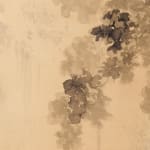




Gankyo Kishi
Landscape, Late 19th - Early 20th century
Sumi Ink and Color on Paper
51 1/2'' h x 26 3/4'' w
Sold
Further images
Is this a landscape, a painting of plants, or a waterfall? Does it matter? Early abstract artists in Western World defended their work by claiming that they wanted to create...
Is this a landscape, a painting of plants, or a waterfall? Does it matter?
Early abstract artists in Western World defended their work by claiming that they wanted to create the visual equivalent of a piece of music. They hoped that their paintings, like music, could be appreciated purely for what they were, without needing to answer to the burdensome question: “what is this painting of?” As history has revealed through the great explosion of abstract art that followed, they were onto something. Must we know what a song is about in order for it to move us to dance?
Even though this work was created before the abstract art “movement” took shape, we need not ask ourselves “what is this painting of?” It could be a landscape seen through mind’s eye of the artist, or an imagined interior landscape of the artist’s mind. Either way, those definitions simply cover two sides of the same coin, which are all contained within the painting’s delicate, hazy surface. The painting’s forest of mark making elegantly floats between abstract and representational expression, eschewing any real desire to distinguish between the two in the viewer’s mind. Instead, one is compelled to regard the work with their mind’s eye and melt with pleasure into its visual environment.
This work would fit comfortably on the wall of a modern home, especially since it anticipates the movement of modern art so directly. Wherever it goes, it will allow a sense of meditation and air and calm to permeate its surroundings.
About this Artist
Gankyo was the third generation of artists from the Kishi School* that was founded by his grandfather Ganku. He was well known for his good command of Japanese color pigments made out of minerals.
*In the history of Japanese art, it was common that a school of art adopted its founder’s family name as the name of the school, which was hereditary as opposed to simply aesthetic or conceptual as with Minimalism or Abstract Expressionism.
Early abstract artists in Western World defended their work by claiming that they wanted to create the visual equivalent of a piece of music. They hoped that their paintings, like music, could be appreciated purely for what they were, without needing to answer to the burdensome question: “what is this painting of?” As history has revealed through the great explosion of abstract art that followed, they were onto something. Must we know what a song is about in order for it to move us to dance?
Even though this work was created before the abstract art “movement” took shape, we need not ask ourselves “what is this painting of?” It could be a landscape seen through mind’s eye of the artist, or an imagined interior landscape of the artist’s mind. Either way, those definitions simply cover two sides of the same coin, which are all contained within the painting’s delicate, hazy surface. The painting’s forest of mark making elegantly floats between abstract and representational expression, eschewing any real desire to distinguish between the two in the viewer’s mind. Instead, one is compelled to regard the work with their mind’s eye and melt with pleasure into its visual environment.
This work would fit comfortably on the wall of a modern home, especially since it anticipates the movement of modern art so directly. Wherever it goes, it will allow a sense of meditation and air and calm to permeate its surroundings.
About this Artist
Gankyo was the third generation of artists from the Kishi School* that was founded by his grandfather Ganku. He was well known for his good command of Japanese color pigments made out of minerals.
*In the history of Japanese art, it was common that a school of art adopted its founder’s family name as the name of the school, which was hereditary as opposed to simply aesthetic or conceptual as with Minimalism or Abstract Expressionism.




